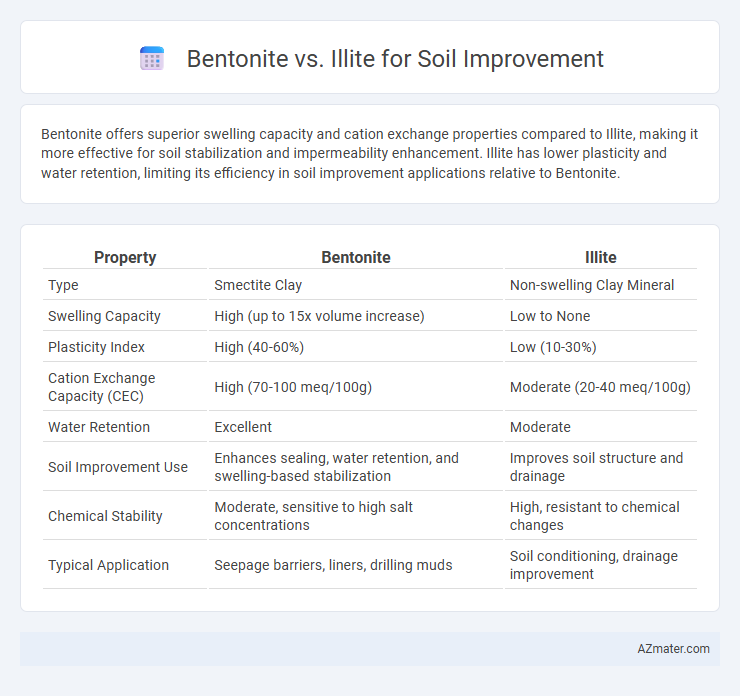Bentonite offers superior swelling capacity and cation exchange properties compared to Illite, making it more effective for soil stabilization and impermeability enhancement. Illite has lower plasticity and water retention, limiting its efficiency in soil improvement applications relative to Bentonite.
Table of Comparison
| Property | Bentonite | Illite |
|---|---|---|
| Type | Smectite Clay | Non-swelling Clay Mineral |
| Swelling Capacity | High (up to 15x volume increase) | Low to None |
| Plasticity Index | High (40-60%) | Low (10-30%) |
| Cation Exchange Capacity (CEC) | High (70-100 meq/100g) | Moderate (20-40 meq/100g) |
| Water Retention | Excellent | Moderate |
| Soil Improvement Use | Enhances sealing, water retention, and swelling-based stabilization | Improves soil structure and drainage |
| Chemical Stability | Moderate, sensitive to high salt concentrations | High, resistant to chemical changes |
| Typical Application | Seepage barriers, liners, drilling muds | Soil conditioning, drainage improvement |
Introduction to Bentonite and Illite for Soil Improvement
Bentonite and illite are clay minerals widely used for soil improvement due to their unique physicochemical properties. Bentonite, primarily composed of montmorillonite, exhibits high swelling capacity and excellent water retention, making it ideal for enhancing soil stability and reducing permeability. Illite, characterized by its moderate cation exchange capacity and lower swelling potential, improves soil texture and nutrient availability, particularly in agricultural applications.
Chemical Composition: Bentonite vs Illite
Bentonite primarily consists of montmorillonite, a smectite clay mineral with high cation exchange capacity (CEC) and swelling properties, making it effective for enhancing soil retention and nutrient availability. Illite, a mica-like clay mineral, contains less expandable layers and has a lower CEC compared to bentonite, resulting in reduced soil plasticity and water retention. The chemical composition differences between bentonite's high sodium and calcium content and illite's potassium-rich structure significantly influence their respective soil improvement capabilities.
Physical Properties and Structure Comparison
Bentonite exhibits a high swelling capacity and excellent water retention due to its montmorillonite-rich, 2:1 layered structure, making it highly effective for soil stabilization and moisture regulation. Illite, characterized by a 2:1 layered silicate structure with non-expanding properties, offers moderate cation exchange capacity and better structural stability, which is beneficial for improving soil texture without excessive swelling. The physical properties of bentonite, including high plasticity and permeability reduction, contrast with illite's lower plasticity and resistance to volume change, influencing their respective roles in soil improvement applications.
Water Retention Capabilities
Bentonite exhibits superior water retention capabilities compared to illite due to its high swelling capacity and large surface area, allowing it to absorb and hold significant amounts of water. Illite has a lower swelling capacity and smaller surface area, resulting in reduced water retention efficiency in soil amendment applications. The choice between bentonite and illite for soil improvement largely depends on the required moisture retention, with bentonite favored for enhancing water availability in arid or drought-prone soils.
Cation Exchange Capacity Differences
Bentonite exhibits a significantly higher cation exchange capacity (CEC), often exceeding 70 meq/100g, compared to illite's moderate CEC values around 20-40 meq/100g, making bentonite more effective in nutrient retention and soil fertility enhancement. The smectite clay mineralogy of bentonite provides expansive layers and greater surface area, facilitating superior adsorption of cations. In contrast, illite's non-expanding structure limits its CEC and reduces its efficiency in improving soil nutrient availability and water retention.
Impact on Soil Fertility
Bentonite significantly enhances soil fertility by improving water retention, nutrient availability, and cation exchange capacity, making it effective for sandy or degraded soils. Illite contributes to soil fertility by supplying essential minerals like potassium and improving soil structure, but its lower swelling capacity limits water retention benefits compared to Bentonite. The combined use of Bentonite and Illite can optimize soil nutrient dynamics and water-holding properties, promoting healthier plant growth.
Application Methods for Bentonite and Illite
Bentonite is commonly applied in soil improvement through slurry trenching, mixing with soil for stabilization, or as a sealant due to its high swelling capacity and impermeability. Illite is typically integrated by blending with soil to enhance cation exchange capacity and nutrient retention, often used in agricultural soil amendments rather than structural applications. Both minerals improve soil properties but differ in application techniques driven by their distinct physicochemical characteristics.
Environmental Benefits and Considerations
Bentonite enhances soil structure by improving water retention and nutrient availability, reducing the need for excessive irrigation and fertilization, which lowers environmental impact. Illite promotes soil aeration and microbial activity, supporting sustainable plant growth while minimizing chemical inputs. Both clays contribute to soil remediation and erosion control, but bentonite's higher swelling capacity offers superior water management benefits in drought-prone areas.
Cost-Effectiveness and Availability
Bentonite offers superior swelling properties and high cation exchange capacity, making it highly effective for soil stabilization, but it generally comes at a higher cost and limited availability in some regions. Illite, while less potent in improving soil texture and nutrient retention, tends to be more abundant and affordable, making it a cost-effective choice for large-scale or budget-conscious projects. Selecting between bentonite and illite depends on balancing the desired soil improvement outcomes with budget constraints and local supply conditions.
Choosing the Right Clay for Your Soil Type
Bentonite and illite are distinct clays with different properties crucial for soil improvement; bentonite, rich in montmorillonite, offers high swelling capacity and excellent water retention, making it ideal for sandy or coarse soils requiring enhanced moisture control. Illite, with lower swelling potential and moderate cation exchange capacity, suits loam or clay soils needing improved nutrient availability without excessive shrink-swell behavior. Selecting the right clay depends on soil texture, drainage requirements, and the specific goals of soil amendment to optimize plant growth and soil structure.

Infographic: Bentonite vs Illite for Soil improvement
 azmater.com
azmater.com